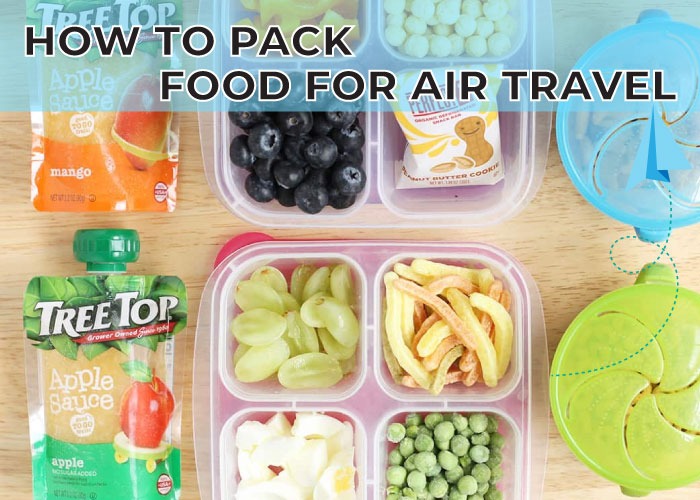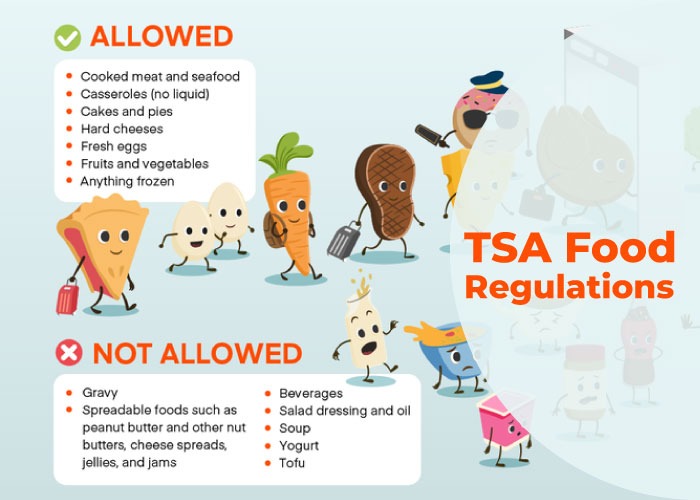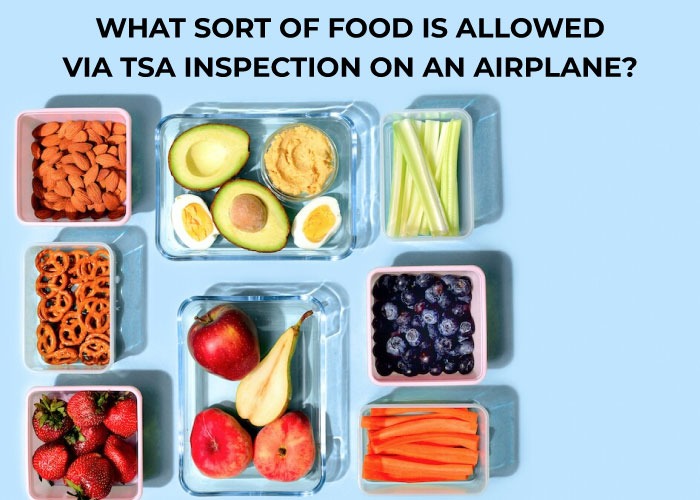Are you bringing homemade meals with you on your upcoming flight? Just remember to abide with the airline’s policies, pack non-perishable and mildly scented meals, practice good hygiene, and show consideration for other travelers. Let’s talk about How to pack food for air travel.
Bringing Food from Home during a Flight? Adhere to These few Suggestions. Are you wondering what foods you can bring in your hand luggage if you’re planning an airline trip? We have everything covered. We’ll go over the dos and don’ts of packing homemade food in your hand luggage in our extensive guide to make your trip hassle-free.
TSA Food Regulations
Almost any food can be brought on a flight, however if it contains any liquid, paste, or gel, that portion of the snack must adhere to the 3-1-1 rule:
3. (Every liquid, paste, or gel needs to be in a container weighing 3.4 ounces or less.)
1. (Every liquid bottle needs to fit into a single quart-sized bag.)
1. (Per person, one bag)
This comprises spreadable dips like hummus and cream cheese, nut butters, ice cream, jams and jellies, honey, maple syrup, oils and vinegars, salad dressings, salsas, and sauces, soups, and yogurt.
Keep in mind that you should be OK to go if the liquid-like items are already on a salad or sandwich that is securely packed in your carry-on.
What sort of food is allowed via TSA inspection on an airplane?
How to pack food for air travel is a common question for every person who travel from air. Almost any packaged, solid food can be brought on an aircraft as long as it fits into your carry-on luggage with ease. This include salads, sandwiches, wraps, pizza, spaghetti, and hard-boiled eggs in addition to bread, cooked meat, nuts, sweets, cereal, cookies, crackers, chips, and dried fruit. (Remember the 3-1-1 rule for sauces, dressings, and other separately packaged items.) In general, fresh fruit and vegetables are also acceptable; however, there are a few exclusions listed below.
TSA regulations that is specific to baby food, breastfeeding, and formula
For your children, carry-on bags containing formula, breast milk, and juice are OK through security as long as the TSA’s hazy description of “reasonable quantities” is followed and the items are removed to allow for separate screening. You may be asked to put these items through an X-ray, open their containers, or pour out a small amount of liquid so that a TSA officer can inspect them. You are under no obligation to comply with these requests, but if you refuse, the TSA officer may choose to pat you down, check your carry-on bag, or do other actions.
How to Pack Food for an Air Trip:
Food should be stored in airtight containers.
Put your food in sealed containers to avoid spills and to preserve its freshness. Additionally, this will keep the food’s scent intact and stop it from getting on the rest of your hand luggage. Aluminum foil, plastic containers, and ziplock bags are excellent choices for safely storing your food.
Eat Less Foods That Smell Strong:
Even though Indian food is renowned for its potent flavors and fragrances, it’s advisable to avoid bringing items with overpowering scents in your carry-on luggage. You and the other passengers will have a comfortable journey as a result. For example, pickles with grapes
Recognize Any Liquid Limitations:
Keep in mind that there are tight regulations on liquids, gels, and pastes in hand luggage on airlines. This comprises products such as yogurt, gravies, sauces, and chutneys. If you must carry these, make sure they are in 100 ml or smaller containers and put them in a clear plastic bag that can be sealed.
Think About Ready-to-Eat Foods:
Packing ready-to-eat meals is an option if you’re pressed for time or don’t want to make meals before your flight. These may be found in most supermarkets and are available in a number of varieties, including chole, rajma, and biryani. Just be sure to select alternatives that don’t call for heating, as your flight may not allow for this.
Remember to Bring Utensils:
Remember to bring disposable cutlery, like napkins, forks, and spoons. This will facilitate your enjoyment of your homemade meal while in flight.
Recognize dietary restrictions and allergens:
Take into account any dietary requirements or any allergies that can affect you or your fellow travelers when packing food for your trip. In desi cuisine, common allergies include dairy, gluten, and nuts. It is recommended to avoid bringing any food in your hand luggage if you are not sure what’s in it.
Select Foods That Are Temperamentally Stable:
Selecting food items that are resilient to temperature changes is crucial because aircraft cabins are subject to variations in temperature. Choose foods that are safe to eat at room temperature and don’t need to be refrigerated.
Put Labels on Your Food Containers:
You could want to name your food containers so that security staff have an easier time figuring out what’s inside your hand luggage. By doing this, any misunderstandings or hold-ups during the security check procedure may be avoided. To write the dish’s name on the container, use a marker or a simple adhesive label.
Maintain Proper Hygiene:
When handling food while traveling, it’s important to practice good cleanliness. Ensure that you properly wash your hands both before and after eating. Keeping antibacterial wipes and hand sanitizer on hand can also help you maintain clean, germ-free hands.
Ice packets that are frozen
As long as they are frozen when you pass through security, ice packs, freezer packs, frozen gel packs, and other cooling accessories are permitted in carry-on luggage. They won’t be allowed through if the TSA discovers that they are partially melted or that there is liquid at the bottom of their container.
Verifying what you are not allowed to bring on board
You have two options if the TSA stops you at security because of food, drink, or size that it deems inappropriate: Either turn in the item to be disposed of, or exit the security area, repack the item or items that were not authorized, and head back to the airline’s ticket office to check that particular piece of luggage. Yes, you will need to abide by the weight restrictions for checked bags set by your airline and yes, you will need to go through security once more.
Conclusion
Finally from this blog we get to know about How to pack food for air travel. There are a variety of snack alternatives that you may bring on board with you in 2023. If you want to avoid having to buy drinks and snacks on flights. But, you must confirm that the meals. You plan to eat meet TSA requirements for both solid and liquid items before you travel to the airport. Making sensible snack choices will help you and your family stay energized while traveling and prevent you from paying exorbitant fees for the food and beverages that are offered at airports.



